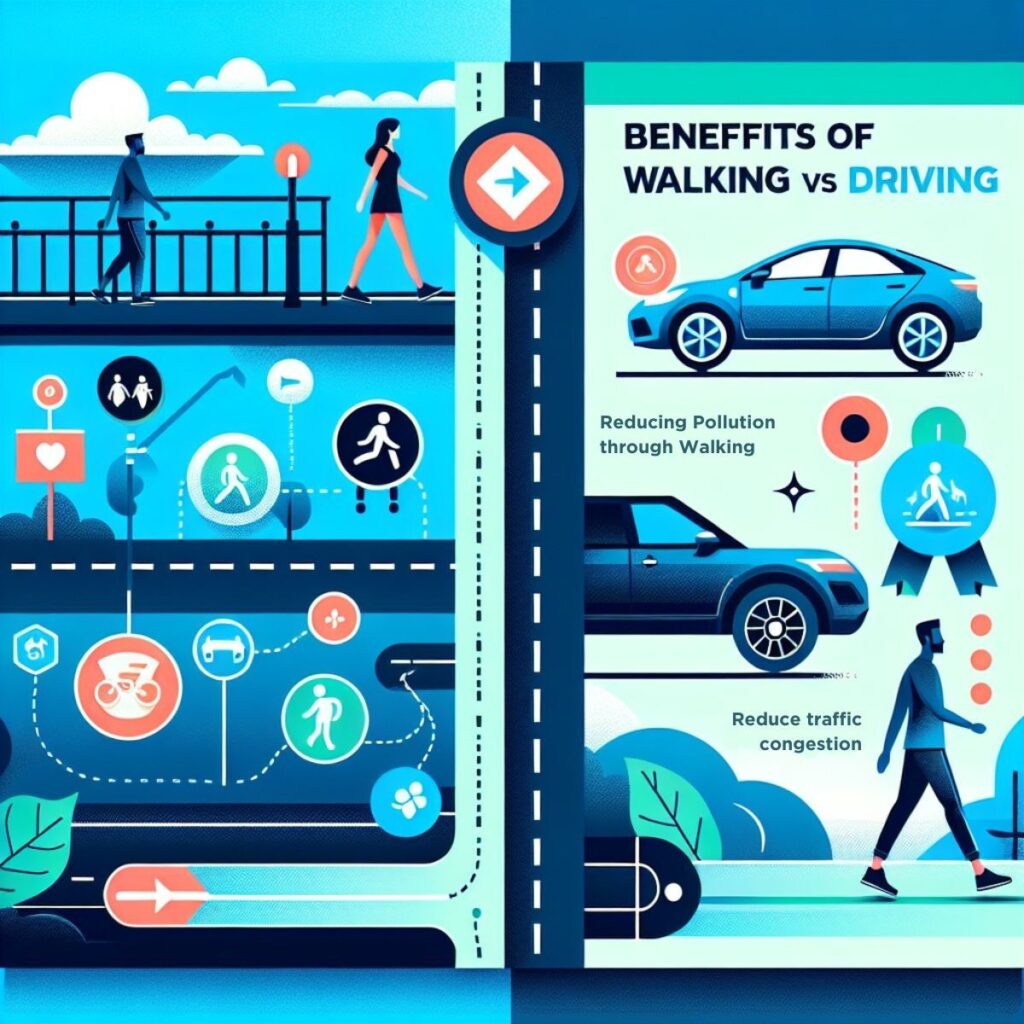We all know that walking is good for us, but have you ever thought about how it could revolutionise your short trips? Walking isn’t just a way to get from A to B; it’s a powerful tool to improve our health and the environment. From reducing our carbon footprint to boosting our mental wellbeing, choosing to walk for those quick errands or short commutes can have a big impact on our lives and communities.
In this article, we’ll explore why walking should be your go-to choice for short journeys. We’ll look at how those quick car trips affect our world, and why swapping them for a stroll is a smart move. We’ll also dive into how cities are changing to make walking easier and more enjoyable. Plus, we’ll check out some cool tech that’s making it fun to leave the car at home. By the end, you’ll see how taking those first steps can lead to a healthier you and a greener planet – and you might even earn some rewards along the way!
Understanding the Impact of Short Car Trips
We often hop into our cars for quick errands without giving it a second thought. But these short trips have a bigger impact than we might realise. Let’s take a closer look at how these brief journeys affect our environment, our roads, and our health.
Environmental consequences
When it comes to the environment, those quick car trips add up. In the UK, transport accounts for 24% of total greenhouse emissions, with a whopping 52% of that coming from passenger cars. It’s not just about carbon emissions, though. Our increased car use also leads to noise pollution and poor air quality, which affects the very air we breathe .
What’s more, even short trips can have a disproportionate impact. Modern vehicles can emit twice as much pollution in the first five minutes of running . This means that those quick jaunts to the shops or school drop-offs could be contributing more to pollution than we think.
Traffic congestion issues
Short car trips also play a significant role in traffic congestion. When we all jump in our cars for quick errands, it adds up to a lot of vehicles on the road. This congestion doesn’t just slow us down; it has knock-on effects:
- Increased accidents due to less reaction time between cars
- Longer lines of congestion when accidents do occur
- Wasted fuel as we sit idling in traffic
- Increased stress levels during commutes
For those relying on public transport, congestion can make buses less efficient. Since 2000, fuel efficiency for buses has declined by 35%, while carbon dioxide emissions per bus km in urban conditions have risen by 25% . This is partly due to stop-start conditions caused by congestion.
Personal health implications
Beyond the broader environmental and traffic issues, short car trips can have personal health implications too. When we choose to drive instead of walk or cycle, we miss out on opportunities for physical activity.
Moreover, the pollution from these short trips doesn’t just stay outside our cars. Drivers can suffer the worst effects of this pollution burst, as there can be up to double the amount of pollution inside vehicles .
By understanding these impacts, we can make more informed choices about our travel habits. Remember, every time we choose to walk, cycle, or use public transport for short trips, we’re not just helping ourselves, but our community and environment too. And with apps like KORA, we can even earn rewards for making these positive choices!
Walking as a Sustainable Transportation Alternative
We’ve all heard about the benefits of walking, but have you considered how it can revolutionise our cities and help save our planet? Let’s explore why walking should be our go-to choice for short trips and how it can make a real difference.
Reduced reliance on fossil fuels
By choosing to walk instead of drive, we’re taking a significant step towards reducing our carbon footprint. Research shows that if we swap just five 2km car trips a week for walking, we could cut our annual emissions by 86kg . That’s a massive win for our environment! Plus, it’s a simple change that adds up to make a big difference over time.
Decreased demand for parking spaces
Here’s a surprising fact: an area twice the size of Birmingham is dedicated solely to parking cars . That’s a lot of wasted space! By walking more, we’re not just freeing up roads from congestion; we’re also reducing the need for parking spaces. Imagine what we could do with all that extra land – more parks, community spaces, or even affordable housing.
Improved urban air quality
Walking is a breath of fresh air for our cities – literally! By reducing car trips, we’re helping to clear the air we breathe. Less traffic means less pollution, which is great news for our health and the environment. Plus, cleaner air can lead to more green spaces in our cities, as trees and plants thrive better in less polluted areas .
Remember, every step counts. By choosing to walk, we’re not just improving our own health, but we’re also contributing to a cleaner, greener future for everyone. And with apps like KORA, we can even earn rewards for our eco-friendly choices. So, let’s lace up our shoes and start making a difference, one step at a time!
The Role of Walking in Urban Planning and Design
We’re seeing a shift in urban planning that puts walking at the heart of city design. This change isn’t just about making our cities more pleasant; it’s about creating healthier, more sustainable, and more connected communities.
Creating pedestrian-friendly infrastructure
To make walking a viable option, we need to focus on creating the right infrastructure. This means more than just laying down pavements. We’re talking about designing spaces that make walking safe, comfortable, and enjoyable.
Key elements of pedestrian-friendly infrastructure include:
- Well-designed footpaths with clear zones for walking, street furniture, and buffers from traffic
- Safe pedestrian crossings with appropriate signalling
- Accessibility features for people with different abilities
- Safety measures to protect pedestrians from traffic
- Reduced pollution and noise levels
- Interesting scenery and visually appealing spaces
By implementing these features, we can create environments where walking becomes the natural choice for short trips.
Integrating walking paths with public transport
Walking and public transport go hand in hand. When we design our cities with this in mind, we create what’s known as Transit-Oriented Development (TOD). This approach puts walking at the apex of transit and city design .
In TOD communities, a blend of services, residences, and amenities are built around centralised transport hubs, all reachable on foot within 10–20 minutes. This design not only encourages walking but also increases the use of public transport. For example, in Portland, 45% of the population lived in TOD communities in 2012, leading to a significant increase in transit trips .
Developing mixed-use neighbourhoods
Mixed-use neighbourhoods are a key component of walkable cities. These areas combine residential, commercial, and recreational spaces, allowing residents to access essential services without relying on cars.
The benefits of mixed-use neighbourhoods include:
- Reduced reliance on cars, leading to decreased traffic congestion and improved air quality
- Improved public health due to increased physical activity
- Enhanced community engagement and social interaction
- Better work-life balance with reduced commuting times
By integrating these principles into our urban planning, we’re not just making our cities more walkable – we’re creating more liveable, sustainable, and connected communities. And remember, with apps like KORA, we can even earn rewards for choosing to walk, making the shift to a more pedestrian-friendly lifestyle even more appealing.
Technology and Tools to Encourage Walking
In today’s digital age, we’ve got a wealth of tools at our fingertips to make walking more engaging, enjoyable, and rewarding. Let’s explore some of the innovative technologies that are helping us put our best foot forward.
Route planning for pedestrians
Gone are the days of getting lost on our walks. Route planning apps have made it easier than ever to discover new paths and plan our journeys. Google Maps, a widely used route planner, offers real-time navigation for walking, driving, cycling, and public transport .
For those of us who love exploring off the beaten path, apps like Komoot are designed specifically for off-roaders but also offer route planning for walks and hikes. It provides hand-picked guides and ready-built, localised routes that fit our needs .
Another interesting option is the Footpath Route Planner. This app allows us to measure distances by simply tracing a map with our finger. It then snaps to roads and trails on the map, making route planning a breeze .
Gamification of walking activities
To make walking even more engaging, many apps have introduced gamification elements. These features turn our daily walks into fun challenges and competitions.
Research shows that during walking competitions, the average user increases physical activity by 23%. This increase is seen across all ages, genders, and weight statuses, even for those who were previously fairly inactive .
And let’s not forget about the KORA app, which rewards us for our walks. It’s not just about the steps we take, but the positive impact we’re making on our health and the environment. With KORA, every step counts towards a healthier us and a greener planet.
By leveraging these technologies, we’re not just making walking more accessible and enjoyable; we’re creating a community of walkers, all striving towards better health and a more sustainable future. So, let’s lace up our shoes, grab our smartphones, and start exploring the world on foot!
Conclusion
Walking has a profound influence on our health, environment, and urban landscapes. By choosing to walk for short trips, we’re not just improving our personal wellbeing, but also contributing to cleaner air, less traffic, and more liveable cities. What’s more, with the rise of pedestrian-friendly urban planning and innovative technologies, walking is becoming an increasingly attractive and rewarding option for everyday journeys.
As we step towards a more sustainable future, tools like the KORA app are making it easier and more enjoyable to embrace walking as a lifestyle choice. These apps not only help us track our progress and plan our routes but also offer rewards for our eco-friendly choices. To get the full benefits from your sustainable journeys, download the KORA app today. By lacing up our shoes and hitting the pavement, we’re not just taking steps for ourselves, but for a greener, healthier planet.
FAQs
1. How does walking contribute to reducing pollution?
Walking instead of driving, especially for short trips, can significantly cut down on car emissions. Research shows that if you walk for five 2km trips each week rather than driving, you could reduce your emissions by 86kg annually.
2. What are the environmental benefits of walking to school?
Walking to school helps reduce environmental impact by lessening congestion and traffic, which in turn decreases pollution.
3. What are the goals of London’s walking strategy?
The Mayor’s Transport Strategy in London aims for 80% of all trips to be made on foot, by bicycle, or using public transport by 2041. This strategy focuses on enhancing health and the quality of urban experiences.
4. What does the Cycling and Walking Investment Strategy (CWIS) entail?
The second Cycling and Walking Investment Strategy (CWIS2) sets forth the government’s plan to make cycling and walking the preferred options for shorter trips, or as part of a longer journey, by the year 2040.




